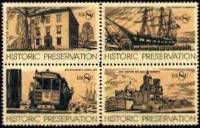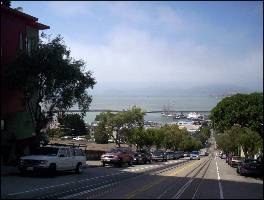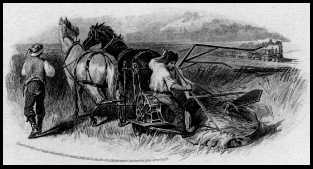
|
<<<< |

|
>>>> |

|

TRAINS ON U. S. STAMPS
and POSTAL STATIONERY
page 5

Embossed postcard with train image - 20th Century Limited |
8¢ SAN FRANCISCO CABLE CAR, HISTORIC PRESERVATION ISSUE
|
|||

Sc. 1440-43 - issued 10/29/71 |

Sc. 1442 - issued 10/29/71 |
I don't collect cable cars, but many rail philatelists do, and this stamp is in the ATA Handbook, hence I am including it here.
I live near San Francisco, and love to ride the cable cars every chance I get. The California Street line is my favorite, as it is used mostly by locals, and feels like quaint but practical transportation, rather than a theme-park ride, which is all the other lines are.
The view on this stamp is from Hyde street, looking North towards the San Francisco Bay. There is an old sailing vessel (The Balclutha) moored at the Hyde Street Pier, though the actual view at the bottom of that hill would look more like this, i.e. the artist has omitted some details to simplify the stamp's image. I assume the image was based on a photo, so the next time I go over to the City I intend to see if I can determine the exact spot from which that photo was taken - stay tuned. In the meantime, Here is a map of the cable car lines, so you can see the layout. My guess is that the stamp's view is from the corner of Hyde and Filbert.
5/14/2007
Today is the 10th anniversary of the first presentation of Alphabetilately
as a slide show, so I met two other veterans of the project for a commemorative lunch,
and took advantage of the opportunity to find out the exact location of the view on
Scott 1442. I was three blocks off - it's from about half a block below the corner
of Hyde and Chestnut. As I mentioned above, the artist omitted some key features of
the scene - mainly the jetties - and shortened the perspective,
but I think it's clear this is the view.
USPS publicity for this issue stated:
Four jumbo-sized stamps, setenant, were released October 19, 1971, in San Diego, Calif., commemorating the historic preservation movement in the United States. First day ceremonies were held in conjunction with the annual conference of the National Trust for Historic Preservation.
The horizontal designs chosen to begin this series are representative of four areas: Decatur House, built in 1819 in Washington, D.C., by Commodore Stephen Decatur and now a house museum; a 19th century whaling vessel anchored in Mystic, Conn.; a San Francisco cable car which still operates on 10 miles of track; and San Xavier del Bac Mission, near Tucson, Ariz., in existence since 1797.
These stamps were printed on a light beige paper with a darker beige applied by offset, and the dark brown engraved design by the Giori intaglio press. The stamps, 1.80 by 1.05 inches each, were issued in panes of 32.
That text implies there were supposed to be further issues on this theme, but none ever appeared.
I wanted to confirm the statement that only ten miles of cable-car track survive, and learned HERE (scroll down to June, 2004) that the correct number is 8.8 miles of "revenue track" on three lines, with 37 cars in service. I also wanted to know how many miles of cable-car track were in service at the system's peak, and after some frustrating dead-ends, found (where else?) at the Rice-A-Roni web page, that "Prior to 1906, the system had 600 cars rolling on 22 cable lines over 110 miles of track." That seemed too low, but then I realized the cable cars were used mainly on the steep hills, while self-propelled systems covered the easier terrain of the City.
These stamps were designed by Melbourne Brindle, and printed using a combination of lithography and engraving. Over 170 million were printed, making them still relatively common today, and worth little more than their face value. There are two missing color errors, "black brown omitted", valued at $2,250 for a block of four, and "ocher omitted", no value given. There is also a "tagging omitted" error, valued at $65 for the block.
As I said at the beginning of this entry, I do not collect streetcars, cable cars, etc. - only trains - so I have no FDCs for this stamp. All that I have seen simply echo the scenes on the stamps, shuffled in various ways.
A San Francisco cable car appears on another U.S. stamp as well, a 20¢ 1988 Transportaion Coil -
more about that stamp here.
US TRAINS
|
Send feedback to the webmaster: CLICK HERE
Revised -- 5/14/2007





